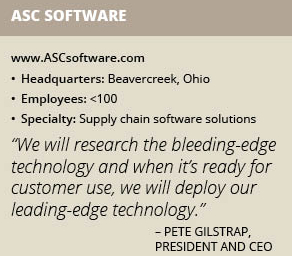
Driving Supply Chains: ASC CEO’s Insight
ASC Software President and CEO Pete Gilstrap compares managing a manufacturing supply chain to driving a car. What information do you need right now to make the important decisions? If you see the gas gauge is low, for example, you need to replenish your supply. “We solve problems,” he says. “We do that with software, but we have to be pragmatic in our methods, ensuring that we solve something and we’re not creating a different problem. We have to take customers through a paradigm and never assume that we know anything.”
Gilstrap is a logistics instructor who, after 40 years of experience in the industry, teaches supply chain best practices and is often a keynote speaker on that topic at industry events. He got his start as a manufacturing engineer for a Fortune 100 company, helping to design manufacturing solutions for the company’s challenges. He eventually got into designing barcode systems during that time, and seeing a void in the market, worked with a partner to found ASC in 1989.
Headquartered in Beavercreek, Ohio, ASC is dedicated to providing innovative supply chain software solutions for solving complex challenges. The company takes pride in providing solutions that are made, tested and supported in the United States, serving manufacturers and distributors in all industries. ASC excels in the pharmaceutical and food manufacturing and distribution markets, but it also specializes in the consumer packaged goods and automotive sectors. Some of ASC’s solutions are even attached to larger entities like SAP for more complex problem solving that SAP cannot handle.
“If we can serve pharmaceutical sectors, and companies that make wind turbines – we can adapt to just about any vertical industry,” Gilstrap says. “If you can meet the objectives for FDA criteria in pharmaceuticals and food – where they have the strictest supply chain requirements for a software product – everything else is easily managed. We provide mission-critical solutions to these industries, and they absolutely, positively have to have a product that works.”
ASC Software is recognized as delivering “best-of-breed” WMS solutions and has received awards such as Top 100 IT Solutions Providers in the world for the 16th year in a row, Top 10 Warehouse Management Solutions Providers 2019, Best-in-Class Design for Wireless Infrastructure and the Microsoft Pinnacle Award for Innovation because of its dedication to innovative solutions, and customer service and support.
“To date, there have been no failures with our solution, and we are very proud of that,” Gilstrap says. “We have had the same company name since we started, and we partner with our customers to make sure they succeed; if they fail, we fail. Our support team, which is based here in the United States, knows our customers on a first-name basis.”
Data Management
Last year, ASC began realizing objectives in Industrial Internet of Things (IIOT) that it tested before the technology existed. To date, the company is even more focused on enhancing IIOT manufacturing data capabilities to use predictive analysis to solve even more issues and create efficiencies for customers. “We have designed our software to ensure that the information that the managers get is not information overload,” Gilstrap explains. “A human engineer can only handle so much information.”
With so much accurate and reliable information at supply chain managers’ fingertips today, ASC is compiling all that data into dashboards to allow for management decisions to be made quickly and easily. “It’s basically like the dashboard in a car. You can see all the important information right up front in order to make a snap decision whether or not to proceed or make adjustments,” Gilstrap says. “It provides instant information to make decisive decisions fast.”
ASC recently debuted its user-defined dashboard for manufacturing, distribution and supply chain managers. Each user can pick and choose different information they want right at their fingertips to manage effectively. “It’s a really nice toolset,” Gilstrap notes. “This is the type of tool that makes IIOT more advanced. I used to manage 530 people and I remember thinking, ‘If only I had a tool to tell me all the information I needed to know now.’ The first step, that systems like ours have been doing, is getting all the accurate, reliable information. Today, we are  focused on taking that accurate, reliable information and putting it into a management, quick-action display.”
focused on taking that accurate, reliable information and putting it into a management, quick-action display.”
Preparing for Blockchain
After four decades in the industry, Gilstrap says he can see cycles and predict things five to 10 years in advance. His vision is that blockchain will become the next big thing in electronic data interchange (EDI). Blockchain is digital information stored in a central database. “Some of the large shipping companies have invested more in this technology, whereas previously, GPS tags are primarily put in shipping containers by the vendors and shipping lines had no part in it,” he says. “By shipping lines taking an active role in providing this information, the bigger picture of what we are getting ready to do is more into blockchain.”
What is blockchain in a supply chain? “It’s really the ability to get validated information or secured information from a vendor or supplier to the recipient for tracking specific goods through the supply chain,” Gilstrap explains. “It’s very similar to EDI, which has been the standard for more than 30 years, and EDI works. But blockchain is more of a validation tool or trusted data in a central repository.”
Prior to blockchain, EDI was passed through value-added networks or point to point and hopefully the data could be trusted. “I have done work with the FDA in the past on the Drug Quality and Security Act, and what I tried to solve is how you manage the actual physical goods from Point A to Point B to Point C to Point D,” Gilstrap says.
For example, it is critical that when a cancer drug reaches the end-user, it is in fact the drug. If the drug does not work properly and the patient dies, forensic analysis can analyze the drug to see if it is a fake drug or not. The question then becomes “How did this fake drug get into the supply chain?” “They start at Point A and end at Point E, but what happened in between?” Gilstrap asks. “It could have been made in Country A, shipped to Country B then to Country C and then Country D and then down to the recipient country. It changed hands so many times, who had it, how long did they have it and where did it go? Blockchain is used as a way to send validated information about specific serial numbered goods.”
Obviously Gilstrap can’t know for sure whether blockchain will catch on, but he predicts, in the next 10 years, the GS1 and blockchain standards will become merged. GS1 sets the standard for EDI. “I see blockchain as becoming the next thing in EDI,” he adds. “It’s not readily adopted just yet, but we’ll be ready for it when it gets here. You have to have vendors and customers wanting to adopt the standard, and if they don’t, it dies out and that happens in the industry a lot.”
ASC is equipped to handle the move to blockchain once its customers decide whether or not they want to adopt the technology. The company anticipates the food and pharmaceutical industries to be the first ones, if any, to adopt blockchain. “We are the software toolset,” Gilstrap says. “If the vendor/customer relationships want the blockchain, we are here to support that. We will research the bleeding-edge technology and when it’s ready for customer use, we will deploy our leading-edge technology.”
Connected Supply Chain
New this year are long-range imaging scanners for warehouses that will scan a barcode from 70 feet. “This fantastic new hardware was recently announced. Being an engineer myself, it takes a lot to impress me, and I’m impressed with the new technology of scan engines,” Gilstrap says. “Twenty-seven feet is the norm for long-range scanning, but the hardware company achieved 70 feet.”
The new scanners are also equipped with a 12-megapixel camera, which resulted in ASC adding new graphical capabilities to its mobile device software to allow customers to embed photos of their shipment as proof of receipt and proof of shipment. For example, one of ASC’s customers in California has to prove what they put in outbound shipping containers sent to foreign countries.
“In the past, they would get pinged by the recipient who claimed they were shorted five cases. What’s the recourse? They get into a dispute over whether or not it was put in the container, stolen along the route or did the customer just make it up,” Gilstrap explains. “It becomes a bad situation. So, how do you prevent those? Be proactive and take a photo as proof of each pallet to embed that in the pick process by using this new scanner to take a photo right before you put the seal on it. You now have proof it went into the container. That’s a new validation process.”
In the past, this method was prohibitive because the camera wasn’t fast, efficient or embedded and there wasn’t a software tool available. “We knew it was coming and built our tools ahead of schedule to receive the long-range scanners,” Gilstrap says. “We announced our software tool at the same time the hardware company announced the new long-range scanner. The exponential increase in cellular speeds and the new hardware sets we apply our software allows users to have productivity gains, proof of evidence and be fully embedded on the shop floor.”
As the world becomes more connected, ASC’s toolset becomes more connected and dependent on the hardware. The company deals with many systems where there is no room for error, and Gilstrap takes great pride in ASC’s team and the solutions they are able to develop. “We have built an excellent reputation with our client base,” he adds. “We do what we say we are going to do.”